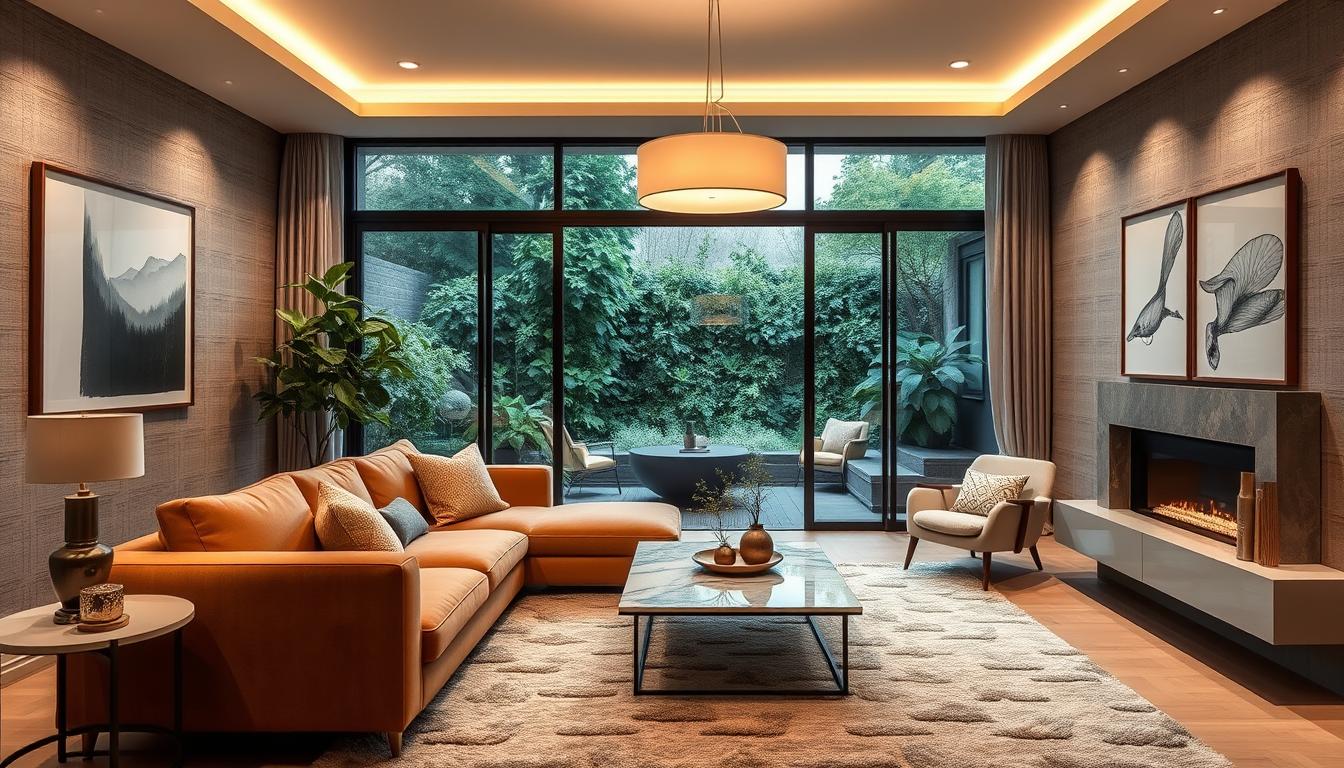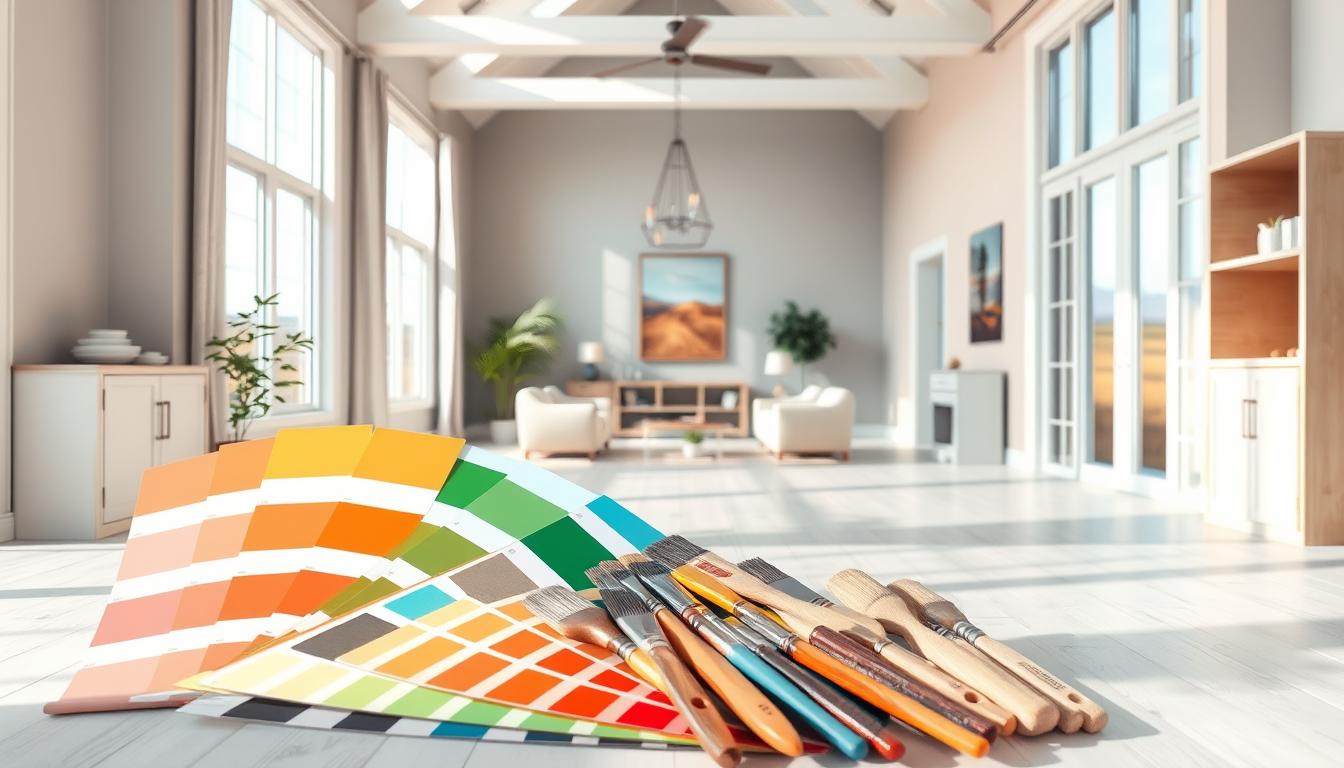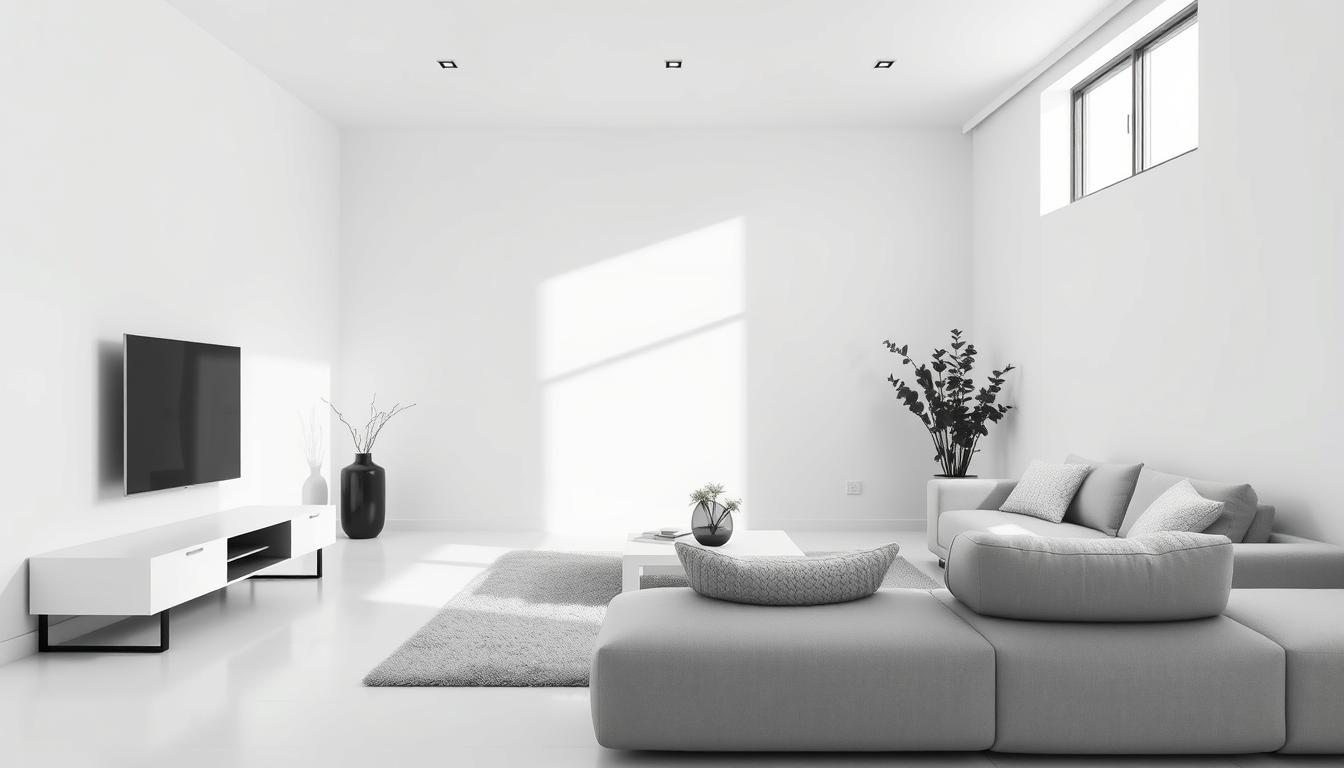Did you know that the way we decorate our living spaces can really affect our mood and how productive we are? With so many interior decorating ideas out there, picking the right one can feel like a big task.
As we look into the top home interior design styles, we’ll check out different decorating ideas. These ideas can turn your living area into a cozy and stylish retreat.
It’s key to know what each style is all about when deciding on your space. In this part, we’ll talk about why picking the right style is important for your living space.
Key Takeaways
- Understanding different home interior design styles
- Exploring various interior decorating ideas
- Learning how to choose the perfect style for your space
- Discovering the impact of decor on mood and productivity
- Getting insights into transforming your living space
Understanding Home Interior Design Styles
The world of home interior design is vast, with many styles to choose from. Each style has its own unique features. It’s important to pick the right style to make a space that shows your personality and meets your needs.
What Are Home Interior Design Styles?
Home interior design styles are about the look and feel of a space. They range from modern home decor to traditional interior design. Each style has its own furniture, color schemes, and architectural details.
These styles can change how a home feels and works. For example, modern decor is all about clean lines and function. Traditional decor, on the other hand, has more ornate details and classic furniture.
Importance of Choosing the Right Style
Choosing the right style is crucial. It affects how your home looks, feels, and works. A good style can make your home more enjoyable and even increase its value.
The right style also shows your personality and taste. Whether you like modern or traditional, picking a style that fits you is key. This way, your home will truly feel like yours.
By knowing the different styles, homeowners can choose wisely. This leads to a space that is both beautiful and functional.
Classic Design Styles
Classic design styles are popular for creating a sophisticated home. They offer timeless elegance that many desire. These styles use traditional elements, rich colors, and classic patterns to create a warm atmosphere.
Traditional Design Elements
Traditional design elements are key in classic interiors. They include rich wood furnishings, intricate patterns, and classic colors. Rich wood adds warmth and depth, while intricate patterns add a layered look.
Classic colors like earth tones and muted hues enhance the timeless feel. Accent pieces like vintage rugs and antique furniture add character and personality.
Iconic Features of Colonial Style
Colonial style is a classic design that has been loved for centuries. It’s known for its symmetrical facades and classic details. Features like columns, pediments, and ornate furnishings bring grandeur and elegance.
The interior of a Colonial-style home is warm and inviting. It uses rich colors, classic patterns, and traditional furnishings. This creates a timeless and sophisticated atmosphere.
Modern Design Trends
Modern design focuses on making spaces look good and work well. It combines minimalism, new materials, and comfort. This creates a unique and inviting atmosphere.
Key Characteristics of Modern Design
Modern design stands out with several key features:
- Clean Lines: Modern spaces have clean, simple lines. This makes them feel open and easy to navigate.
- Minimal Ornamentation: Modern decor doesn’t have too much decoration. It focuses on the beauty of the materials used.
- Functionality: Every part of a modern design has a purpose. It blends form and function perfectly.
Popular Modern Color Palettes
Color is very important in modern design. There are many popular color schemes:
- Neutral Tones: White, beige, and gray are common. They create a calm background for other design elements.
- Bold Accents: Modern spaces use bold colors to add interest. These colors stand out against the neutral tones.
- Monochromatic and Complementary Colors: Modern design often uses one color or pairs colors. This creates a cohesive or dynamic look.
Knowing these design elements and color schemes helps homeowners create a modern space. It can be stylish and functional, showing off the latest in modern home decor.
Rustic and Farmhouse Designs
Bringing rustic and farmhouse designs into your home can make it feel warm and welcoming. These styles use natural materials, vintage decor, and cozy textiles. They create a unique and inviting atmosphere.
Embracing Natural Materials
Rustic design often uses wood, stone, and brick. These materials add warmth and an earthy feel to a room. They bring the outdoors inside, making a room feel cozy.
The Cozy Aesthetic of Farmhouse Style
Farmhouse style is all about comfort and charm. It uses soft lighting, plush furnishings, and warm colors. Vintage or antique pieces add a unique touch to the home.
To show the differences between rustic and farmhouse designs, let’s compare:
| Design Element | Rustic Style | Farmhouse Style |
|---|---|---|
| Primary Materials | Wood, Stone, Brick | Vintage Wood, Metal, Textiles |
| Color Palette | Earth Tones (browns, tans, greens) | Soft Pastels, Whites, Creams |
| Furniture | Heavy, Solid Wood Pieces | Vintage or Antique Pieces, Comfortable Sofas |
By using natural materials and cozy aesthetics, you can make your home warm and inviting. Whether you choose rustic wooden beams or farmhouse vintage decor, these styles offer many options for a beautiful home.
Minimalism and Its Appeal
Minimalism makes our living spaces simpler, bringing calm and clarity. It’s a great way to escape the chaos of modern life. The minimalist design approach offers a peaceful break.
Minimalist design is all about simplicity, clean lines, and few colors. It’s not just about looks. It also makes our homes more functional and efficient.
Principles of Minimalist Design
Minimalist design focuses on simplicity and essential features. It uses a simple color scheme for a unified look. Natural materials and textures add warmth and depth.
- Simplification of spaces
- Limited color palette
- Use of natural materials
- Clean lines and minimal ornamentation
By following these principles, we can make our homes serene and stylish. Minimalist interior design is more than a trend. It’s a lasting way to decorate that suits many lifestyles.
Benefits of a Minimalist Space
Minimalist design has many advantages. It cuts down on clutter, making our homes easier to clean. It also helps us focus better by removing distractions.
| Benefits | Description |
|---|---|
| Reduced Clutter | Less clutter means easier cleaning and maintenance. |
| Improved Focus | A clutter-free environment enhances concentration and productivity. |
| Aesthetic Appeal | A minimalist space is visually appealing and serene. |
Minimalist spaces are also more budget-friendly. They encourage buying quality items that last longer. By using interior decorating ideas that focus on simplicity, we can create a beautiful, lasting home.
In summary, minimalism in interior design simplifies our lives and brings calm. By understanding and applying minimalist design principles, we can enjoy a peaceful, functional space.
Eclectic and Bohemian Styles
Eclectic and bohemian styles let you express yourself in a unique way. They celebrate your individuality and creativity. These styles are great for those who want their home to stand out.
Embracing Individuality
Eclectic design mixes different styles and periods. It creates a space that’s truly yours. Start with pieces you love, like a vintage chair or modern art.
Then, add more items that match or contrast. This makes your space interesting.
Key elements of eclectic design include:
- Mixing different styles and periods
- Incorporating vintage and antique pieces
- Using a varied color palette
- Adding unique decorative items
Mixing Patterns and Textures
Bohemian style loves mixing patterns, textures, and colors. It makes your space lively and full of expression. Start with a neutral base and add layers.
The art of mixing patterns and textures involves:
- Starting with a neutral base
- Layering different patterns and textures
- Balancing bold elements with simpler ones
- Experimenting with different combinations
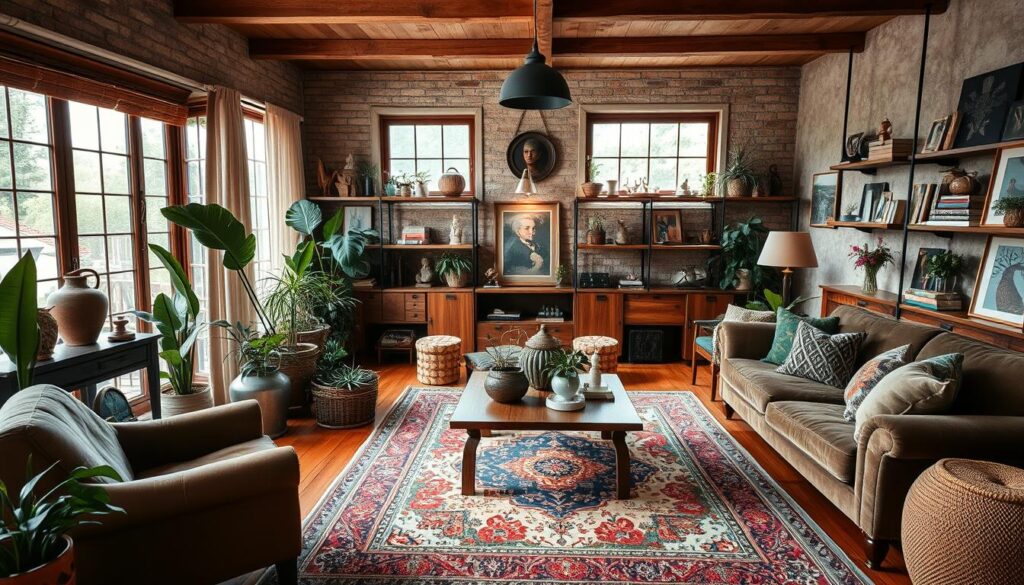
| Element | Description | Example |
|---|---|---|
| Patterned Rug | Adds warmth and texture to the room | Moroccan-inspired rug |
| Textured Sofa | Provides comfort and visual interest | Velvet sofa in a rich color |
| Throw Pillows | Enhances the color palette and adds texture | Pillows in complementary patterns and textures |
By choosing eclectic and bohemian styles, you can make a space that shows off your personality. Whether you prefer eclectic’s mix-and-match vibe or bohemian’s free spirit, the most important thing is to have fun and be creative.
Industrial Design Characteristics
In recent years, industrial design has become a big trend in home decor. It focuses on functionality and a raw, unfinished look. This style uses industrial materials and elements to create a unique, modern living space.
Exposed Elements in Industrial Spaces
Exposed elements are a key feature of industrial design. You’ll often see exposed brick walls, metal beams, and concrete floors. These add to the space’s raw and edgy feel.
Exposed ductwork and pipes are also common. They help make the space feel more industrial. These elements give the space a unique look and make it feel more open and larger.
Color Schemes for Industrial Homes
The color scheme in industrial design usually includes neutral tones. Shades of gray, beige, and brown are common. These colors complement the exposed industrial elements and create a cohesive look.
To add sophistication, bold colors can be used as accents. For example, a vibrant piece of artwork or a bold-colored piece of furniture can stand out against the neutral background. This adds depth and contrast to the space.
By mixing neutral tones with bold accents, industrial design creates a balanced look. It combines raw, industrial elements with modern sophistication.
Contemporary and Transitional Styles
Home interior design is evolving, with contemporary and transitional styles leading the way. They mix modern and traditional elements beautifully. This blend creates a space that is both beautiful and practical.
Contemporary design focuses on today’s trends and a modern outlook. It’s known for clean lines, simple decor, and a focus on function. Let’s look closer at what makes contemporary design special.
Characteristics of Contemporary Design
Contemporary home design is all about the latest trends and tech. It includes:
- Open Floor Plans: Making spaces feel bigger and more open.
- Neutral Color Palettes: Creating a calm and peaceful vibe.
- Minimal Decor: Emphasizing simplicity and usefulness.
To better understand contemporary design, let’s compare it to traditional design in the table below.
| Design Element | Contemporary | Traditional |
|---|---|---|
| Color Scheme | Neutral tones with bold accents | Rich, warm colors |
| Furniture | Sleek, minimalist | Ornate, classic |
| Materials | Glass, steel, concrete | Wood, stone, brick |
How Transitional Bridges Traditional and Modern
Transitional design is a mix of traditional and modern styles. It brings together the elegance of old with the simplicity of new.
This style is all about balance and harmony. It steers clear of the extremes, creating a look that’s both stylish and practical.
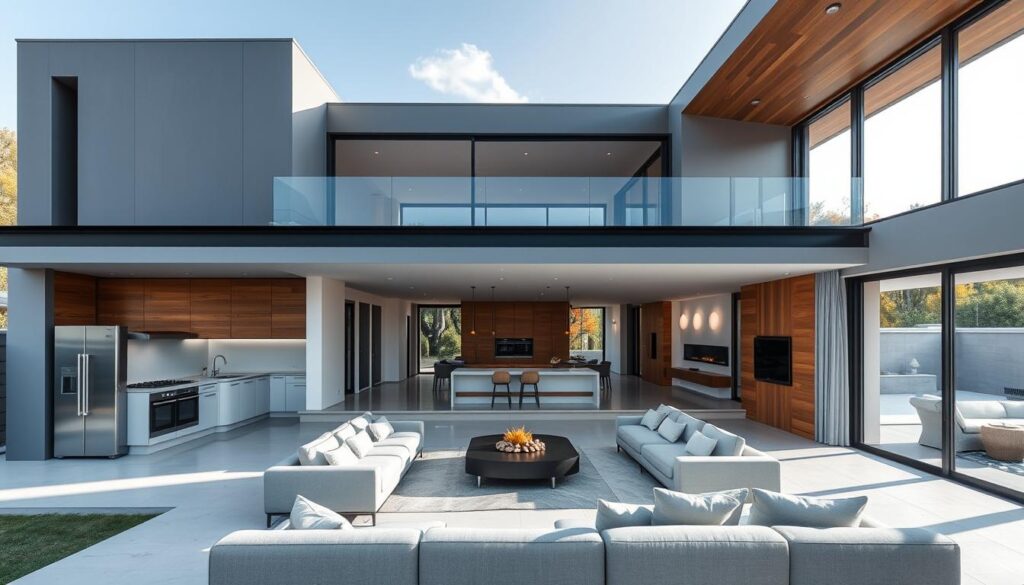
Transitional design combines old and new elements to create a welcoming space. It’s ideal for those who love both traditional and modern styles but can’t choose just one.
In summary, contemporary and transitional styles bring a fresh perspective to home design. They allow homeowners to create spaces that are both beautiful and useful.
Global Inspirations in Interior Design
Global inspirations have changed how we design our homes. They make our spaces more unique and personal. Exploring different cultures helps us find special elements to add to our homes.
Incorporating Global Elements
Adding global elements to our homes is more than just decor. It’s about the cultural and aesthetic value they bring. For example, African patterns can brighten up our living rooms. Asian motifs can bring a calm, simple feel.
Here are some ways to add global touches:
- Use Latin American textiles for furniture and pillows.
- Feature Moroccan tiles in kitchens or bathrooms.
- Introduce Indian block-printed fabrics for curtains or wall art.
Popular Cultural Influences
Interior design is influenced by many cultures, like Japanese minimalism and Scandinavian functionality. These styles offer unique tastes and philosophies. They help us create spaces that are both beautiful and meaningful.
| Cultural Influence | Characteristic Elements | Design Impact |
|---|---|---|
| Japanese | Minimalist decor, natural materials, Shoji screens | Creates a serene and calm environment |
| Moroccan | Vibrant colors, intricate patterns, Zellige tiles | Adds a touch of exotic luxury and warmth |
| Scandinavian | Light woods, minimalist furniture, cozy textiles | Promotes a sense of simplicity and functionality |
By embracing global inspirations, we make our homes richer and celebrate cultural diversity. Whether it’s one special piece or a whole room inspired by a culture, the options are endless.
Tips for Personalizing Your Home Style
Personalizing your home style means making it reflect your personality and needs. It’s about finding a balance between what you like and what’s trendy in home design.
Creating a Unified Aesthetic
To get a cohesive look, pick a theme or style and stick to it everywhere. Choose a few key elements like colors or furniture styles. Use them all over your home. For more ideas, check out Satori Loka’s top home interior design tips.
Balancing Personal Taste with Trends
It’s important to know what’s trendy while staying true to yourself. This way, your home will be stylish and meaningful. Mixing current design trends with your personal style makes your space modern and personal.

